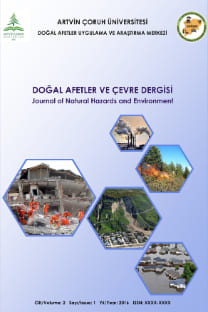Rapor Edilmeyen Sızıntıların Yönetiminde Aktif Kaçak Kontrolünün Planlanması ve Sahada Uygulanması
Dağıtım Sistemi, Aktif Kaçak Kontrolü, Sızıntı Yönetimi, İzole Bölge
Planning and Implementation of Active Leakage Control in the Management of Unreported Leakages
Distribution System, Active Leak Control, Leak Management, Isolated Zone,
___
- AL-Washali T., Sharma S., AL-Nozaily F., Haidera M., Kennedy M., (2018), Modelling the leakage rate and reduction using minimum night flow analysis in an intermittent supply system, Water, 11(1), 48, doi: 10.3390/w11010048.
- Azevedo B.B., Saurin T.A., (2018), Losses in Water Distribution Systems: A Complexity Theory Perspective. Water Resources Management, 32, 2919–2936.
- Boztaş F., Ödemir Ö., Durmuşçelebi F.M., Firat M., (2019), Analyzing the effect of the unreported leakages in service connections of water distribution networks on non‑revenue water, International Journal of Environmental Science and Technology, 16, 4393–4406.
- Creaco E., Campisano A., Fontana N., Marini G., Page P.R., Walski T., (2019), Real time control of water distribution networks: A state-of-the-art review, Water Research, 161, 517–530.
- Choi T., Mijin H., Jinkeun K., Jayong K., (2015), Efficient Minimum Night Flow Analysis Using Bayesian Inference, Journal of Water Supply: Research and Technology-Aqua, 64(1), 10-18.
- Eggimann S., Lena M., Omar W., Mariane Y.S., Dorothee S., Matthew M.D.V., Philipp B., Max M., (2017), The Potential of Knowing More: A Review of Data-Driven Urban Water Management, Environmental Science and Technology, 51(5), 2538–2553.
- Eugine M., (2017), Predictive Leakage Estimation Using the Cumulative Minimum Night Flow Approach, American Journal of Water Resources, 5(1), 1-4, doi: 10.12691/ajwr-5-1-1.
- Farley M.G., Wyeth Z.B.M., Ghazali A., Sigh S., (2008), The Manager’s Non-Revenue Water Handbook. A Guide to Understanding Water Losses, Ranhill Utilities Bernhad and USAID, Malaysia, ss.98.
- Farah, E., Isam S., (2017), Leakage Detection Using Smart Water System: Combination of Water Balance and Automated Minimum Night Flow, Water Resources Management, 31, 4821–4833.
- Fırat M., Orhan C., Yılmaz S., (2021a), Su İdarelerinin Su Kayıp Yönetim Performansının Analizi ve Temel Performans Gösterge Hesaplama Aracının Geliştirilmesi, Doğal Afetler ve Çevre Dergisi, 7(1), 75-88.
- Fırat M., Yılmaz S., Ateş A., Özdemir Ö., (2021b), Determination of Economic Leakage Level with Optimization Algorithm in Water Distribution Systems, Water Economics and Policy, 7(3), 2150014, doi: 10.1142/S2382624X21500144.
- García V.J., Cabrera E., Enrique Cabrera J. (2006), The Minimum Night Flow Method Revisited, In 8th Annual Water Distribution Systems Analysis Symposium, ASCE, Cincinnati, Ohio, USA, ss.1-18, doi: 10.1061/40941(247)35.
- Gomes R., Alfeu S.A., Joaquim S., (2013), District Metered Areas Design Under Different Decision Makers’ Options: Cost Analysis, Water Resources Management, 27(13), 4527–4543.
- Gupta A., Kulat K.D., (2018), A Selective Literature Review on Leak Management Techniques for Water Distribution System, Water Resources Management, 32 (10), 3247–3269.
- Güngör M., Yarar U., Cantürk Ü., Firat, M., (2019), Increasing performance of water distribution network by using pressure management and database integration, Journal of Pipeline Systems Engineering and Practice, 10(2), 1–8, doi: 10.1061/(ASCE)PS.1949-1204.0000367.
- Jadhao R.D., Gupta R., (2018), Calibration of Water Distribution Network of the Ramnagar Zone in Nagpur City Using Online Pressure and Flow Data, Applied Water Science, 8, 29, doi: 10.1007/s13201-018-0672-3.
- Lambert A.O., Brown T.G., Takizawa, M., Weimer D., (1999), A Review of Performance Indicators for Real Losses from Water Supply Systems, Journal of Water Supply: Research and Technology – Aqua, 48(6), 227–237.
- Lima, G.M., Brentan, B.M., Luvizotto Jr., E., (2018), Optimal Design of Water Supply Networks Using an Energy Recovery Approach, Renewable Energy, 117, 404-413.
- Lipiwattanakarn S., Kaewsang S., Pornprommin A., Wongwiset, T., (2019), Real benefits of leak repair and increasing the number of inlets to energy, Water Science&Technology, 14(3), 714–725.
- MASKİ, (2021), İçme suyu dairesi yıllık işletme raporu, Malatya Su ve Kanalizasyon İdaresi Genel Müdürlüğü, Malatya.
- Mutikanga H., Sharma S., Vairavamoorthy K., Cabrera E., (2010), Using Performance Indicators as a Water Loss Management Tool in Developing Countries, Journal of Water Supply: Research and Technology – Aqua, 59(8), 471-481.
- Pearson D., (2019), Standard Definitions for Water Losses: A Compendium of Terms and Acronyms and Their Associated Definition in Common use in the Field of Water Loss Management, IWA Publishing, London, UK, ss.80.
- Roshani E., Filion Y., (2014), WDS Leakage Management through Pressure Control and Pipes Rehabilitation Using an Optimization Approach, Procedia Engineering, 89, 21–28.
- Yılmaz S., Fırat M., Ateş A., Özdemir Ö., (2021), Analysis of Economic Leakage Level and Infrastructure Leakage Index Indicator by Applying Active Leakage Control, ASCE's Journal of Pipeline Systems - Engineering and Practice, 12(4), 04021046, doi: 10.1061/(ASCE)PS.1949-1204.0000583.
- ISSN: 2528-9640
- Yayın Aralığı: Yılda 2 Sayı
- Başlangıç: 2015
- Yayıncı: Artvin Çoruh Üniversitesi Doğal Afetler Uygulama ve Araştırma Merkezi
Sanayi Kaynaklı Noktasal Emisyonların Hava Kalitesine Katkısı: Kayseri İli Örneği
Düzce İli İçin Senaryo Bazlı Risk Değerlendirmesi
Zeynep MIHÇI, Hüseyin BAYRAKTAR
Van Gölü Su Yüzeyi Sıcaklıklarının Eğilim Analizi
Kebir Emre SARACOGLU, Fevziye Ayca SARACOGLU
Çok Değişkenli Kuraklık Frekans Analizi ve Risk Değerlendirmesi: Kahramanmaraş Örneği
Karadere Deresi’nin (Araklı-Trabzon) İçme ve Sulama Suyu Amaçlı Kullanım Uygunluğunun İncelenmesi
Arzu FIRAT ERSOY, Esra HATİPOĞLU TEMİZEL
Van İlinin Afetselliği ve Afet Konutlarında Yer Seçimi Uygulamaları
Cafer GİYİK, Reşat Atalay OYGUÇ, Serhat ANIKTAR
Küresel Isınmanın Etkisi Altında Sürdürülebilir Mimari Tasarım
Sel Afetlerinde Acil Sağlık Hizmetlerinin Organizasyonu ve Yaşanan Sorunlar: Hopa Örneği
